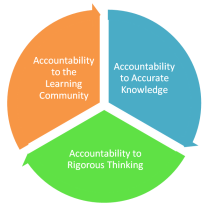Deep Learning Accountable Talk

To define deep learning accountable talk, oral conversations must occur between individuals to support clarification of different points of view. These deep learning discourses are defined in ways teachers hold students accountable for focused conversations.
To qualify for accountable talk teachers design strategies focus on promoting deep learning criteria as clarity is defined in ways students are making contributions to the learning community. For academic conversations to be considered accountable the academic discourse must meet three criteria 1.) the discourse must provide accurate knowledge, 2.) make contributions to the learning community, 3.) and promote rigorous thinking. To characterize accountable talk in high engaged classrooms is in the way a teacher structures classroom norms to promote conversational rigor. These norms are directly associated with scaffold expectations prompting open ended responses either in direct instruction or student reflective discussions.
Student to Student Accountable Talk
But not all classroom discussions sustain deep learning accountable talk. The teacher must also consider classroom participation standards. Teachers by design must go beyond the three criteria for academic discourse by clarifying the norms for student to student participation. To meet the accountable talk student participation standards the a teacher must provide clarity for both speaking and listening. The following criteria provides evidence when identifying student to student accountable talk.
To qualify for accountable talk teachers design strategies focus on promoting deep learning criteria as clarity is defined in ways students are making contributions to the learning community. For academic conversations to be considered accountable the academic discourse must meet three criteria 1.) the discourse must provide accurate knowledge, 2.) make contributions to the learning community, 3.) and promote rigorous thinking. To characterize accountable talk in high engaged classrooms is in the way a teacher structures classroom norms to promote conversational rigor. These norms are directly associated with scaffold expectations prompting open ended responses either in direct instruction or student reflective discussions.
Student to Student Accountable Talk
But not all classroom discussions sustain deep learning accountable talk. The teacher must also consider classroom participation standards. Teachers by design must go beyond the three criteria for academic discourse by clarifying the norms for student to student participation. To meet the accountable talk student participation standards the a teacher must provide clarity for both speaking and listening. The following criteria provides evidence when identifying student to student accountable talk.
- There is evidence of a relationship between the discussion and the stated learning objectives.
- Students design conversational questions requiring higher order thinking (synthesis, analysis, evaluation, problem solving, application of learning)
- Students have a deep understanding of the importance of text features.
- Students understand the importance of data resources when supporting their positioning in academic conversation.
- A set of agreed upon norms for academic discourse are explained by the teacher and are scaffold for clarity.
- Norms for accountable talk are posted for all students to see and follow.
|
Teacher to Student Accountable Talk
Accountable talk can also occur in direct instruction as long as the teacher to student discourse goes beyond surface learning. To move away from surface learning discussions a teacher must understand the effectiveness of question design. Traditionally when teachers are engaging students in direct instruction they use patterns of paraphrasing statements giving consistent feedback to individual students responses.But using direct questioning prompts which provide outlets for fixed answers cannot be considered accountable talk. Too many fixed questions can can actually stifle academic discourse. The typical teacher initiated questions are primarily designed as knowledge level questions. This type of questioning pattern is referred to as (IRE) initiate a fixed answer question, responds by paraphrasing the statement, and then evaluates the level of correctness by using yes or no feedback. The IRE patterns of fixed questioning may reveal correct answers but does not build deep learning nearly as well as open-ended oral discourse. |
|
Accountable talk for deep learning during direct instruction is established when the teacher ask clarify questions. Examples of accountable talk initiated by teacher questions include statements like, "Why do you think that?" Or, "What's your reasoning behind that explanation?" , "Did everyone hear what Bill said and can someone clarify his statement by giving an example?" "Could anyone repeat what Beth said so everyone we can recognize her contribution?" "Does anyone agree or disagree?" "Does anyone want to contribute additional thoughts to Johns statement?" Teachers who aim at designing accountable talk discourses in their classrooms are established by using the following criteria:
- A student can provide explanation of a teacher initiated question by stating the purpose of the question as it relates to the objective.
- The teacher emphasizes the importance of the objective as a technique to redirect discussions when needed.
- The teacher ask open ended questions requiring higher order thinking (synthesis, analysis, evaluation, problem solving, application of learning)
- The teacher provides corrective feedback when needed to give clarity to accountable talk.